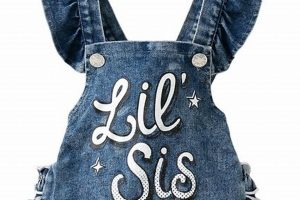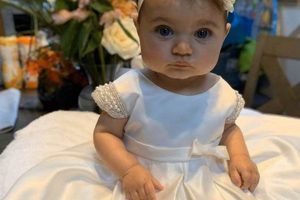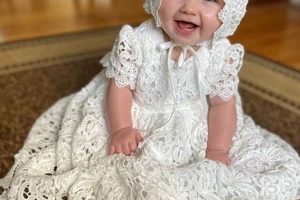Jewelry crafted from a high-purity gold alloy, specifically designed for infants, comprises a particular segment of the adornment market. These items are small, often feature secure closures, and are intended for pierced ears of very young children. The composition, typically 22 karats, indicates a gold content of approximately 91.67%, alloyed with other metals to enhance durability and maintain form.
Selecting high-karat gold for infant accessories offers several advantages. The reduced presence of other metals minimizes the potential for allergic reactions, a crucial consideration for sensitive skin. Gold’s inherent resistance to tarnish contributes to the longevity of the piece, making it a potentially lasting keepsake. Historically, gold jewelry has been presented to infants as a symbol of prosperity and good fortune, a tradition that continues in many cultures.
The subsequent discussion will delve into the factors to consider when purchasing these specific items, focusing on safety standards, design considerations, and responsible sourcing. Further topics include proper cleaning and maintenance procedures, as well as potential investment value.
Essential Considerations for Selecting Infant Gold Earrings
The selection of appropriate jewelry for infants requires careful deliberation, prioritizing safety and suitability. The following guidelines offer crucial considerations for purchasers.
Tip 1: Prioritize Safety Closures: Scrutinize earring backings for secure mechanisms. Screw-back or flat-back designs minimize the risk of accidental dislodgement and potential choking hazards. Regularly inspect these mechanisms for wear.
Tip 2: Size and Weight Considerations: Opt for small, lightweight designs. Excessive weight can cause discomfort or pull on the earlobe, increasing the risk of injury. Choose designs proportional to the infant’s ear size.
Tip 3: Hypoallergenic Properties: While 22k gold offers a high degree of purity, confirm the composition of the alloyed metals. Nickel, a common allergen, should be explicitly absent. Seek certifications or documentation guaranteeing hypoallergenic properties.
Tip 4: Smooth, Rounded Edges: Avoid designs with sharp edges or protruding elements that could scratch or irritate the infant’s delicate skin. Surfaces should be uniformly smooth and rounded.
Tip 5: Professional Piercing Guidance: If the infant’s ears are not yet pierced, consult with a qualified professional experienced in infant ear piercing. Proper piercing technique minimizes the risk of infection and promotes faster healing.
Tip 6: Regular Cleaning Protocol: Implement a consistent cleaning routine. Use a mild, hypoallergenic soap and warm water to gently cleanse the earrings and surrounding skin. Ensure thorough drying to prevent moisture-related complications.
Tip 7: Continuous Supervision: Infants should never be left unattended while wearing jewelry. Close parental or guardian supervision is essential to monitor for any signs of discomfort, irritation, or potential hazards.
Adhering to these recommendations minimizes potential risks and maximizes the suitability of such jewelry for infants. Prudent selection ensures both aesthetic appeal and the infant’s well-being.
The following section will address maintenance and care practices to preserve the integrity and appearance of infant gold earrings.
1. Purity and Hypoallergenicity
The inherent qualities of the material are paramount when selecting adornments intended for infant use. The relationship between purity and hypoallergenic properties is critical, particularly regarding items in direct and prolonged contact with delicate skin, such as gold earrings. The composition directly impacts the likelihood of adverse reactions and subsequent health concerns.
- Gold Content and Allergic Response
The karat value of gold indicates its proportional purity. 22k gold signifies a composition of approximately 91.67% pure gold, with the remaining percentage comprised of alloyed metals. A higher gold content generally reduces the risk of allergic reactions because the allergenic potential typically resides in the alloyed metals, such as nickel, copper, or silver. Lower-karat gold, having a greater proportion of these other metals, proportionally increases the risk of adverse cutaneous responses. Consequently, 22k gold presents a diminished probability of triggering allergic dermatitis compared to alloys with lower gold concentrations.
- Alloy Composition and Metal Sensitivity
The specific metals used in the alloy are critical determinants of the hypoallergenic properties of the jewelry. Nickel is a common sensitizer, known to induce allergic contact dermatitis in susceptible individuals. Even trace amounts can elicit reactions. Therefore, selecting 22k gold items that explicitly exclude nickel in their alloy is paramount. Documentation from the manufacturer verifying the absence of nickel and other known allergens provides crucial assurance. The presence of other potentially problematic metals, such as cobalt or chromium, should also be evaluated.
- Manufacturing Processes and Contamination Risks
The manufacturing process itself can introduce contaminants that compromise the hypoallergenic nature of the material. Residues from polishing compounds or plating solutions may remain on the surface of the earrings, potentially causing irritation. Reputable manufacturers adhere to stringent quality control protocols to minimize such risks. Electropolishing and thorough cleaning processes are essential to remove any residual contaminants. Surface treatments intended to enhance shine or durability should be scrutinized for their potential allergenic effects.
- Long-Term Exposure and Sensitization
Even with a high degree of purity and careful manufacturing, prolonged exposure to 22k gold earrings can, in rare instances, lead to sensitization over time, particularly in individuals with pre-existing sensitivities. Routine cleaning and proper hygiene practices mitigate this risk by removing accumulated sweat, oils, and debris that may facilitate the release of allergenic metals. Signs of irritation, such as redness, itching, or inflammation, warrant immediate removal of the earrings and consultation with a healthcare professional.
The selection of 22k gold earrings for infants must prioritize verified material composition, meticulous manufacturing practices, and ongoing maintenance. These factors collectively minimize the risk of allergic reactions and contribute to the safe and comfortable wear of the jewelry.
2. Safety Closure Mechanisms
The integrity of safety closure mechanisms is paramount when considering gold earrings for infants. These mechanisms directly influence the risk of accidental dislodgement, ingestion, and subsequent choking hazards. Selection requires rigorous evaluation of design and material properties to ensure optimal security and infant well-being.
- Screw-Back Mechanisms: Thread Integrity and Security
Screw-back mechanisms employ a threaded post and backing that must be precisely aligned and securely tightened. The integrity of the threading is critical; worn or damaged threads compromise the closure’s effectiveness. Regular inspection is essential to ensure the backing remains firmly affixed and cannot be easily unscrewed by the infant. The potential for small parts detachment from damaged screw-backs poses a significant aspiration risk.
- Flat-Back Post Designs: Comfort and Reduced Protrusion
Flat-back post designs minimize protrusion behind the earlobe, enhancing comfort and reducing the likelihood of the earring catching on clothing or bedding. The smooth, flat surface distributes pressure evenly, mitigating the risk of pressure sores or skin irritation. However, the clasping mechanism attaching the flat back to the post must be sufficiently robust to withstand normal wear and tear. Weak or poorly designed clasps can lead to unexpected detachment.
- Clutch and Post Systems: Tension Strength and Durability
Clutch and post systems rely on friction to maintain the earring’s position. The clutch, a small metal component, slides onto the post and is held in place by tension. The strength and durability of the clutch are critical factors; repeated removal and insertion can weaken the metal, reducing its grip. Periodic testing of the clutch’s holding force is advisable to ensure adequate retention. The size and shape of the clutch must also be considered to prevent it from becoming a choking hazard if detached.
- Hinge and Latch Closures: Secure Fastening and Tamper Resistance
Hinge and latch closures, while less common in infant earrings, offer a secure fastening method. The hinge allows the earring to open and close, while the latch secures it in the closed position. The latch mechanism should be designed to resist unintentional opening by the infant. High-quality materials and precise manufacturing are essential to ensure the hinge and latch operate smoothly and reliably over time. The potential for sharp edges on the latch should be carefully assessed to minimize the risk of skin irritation.
The selection of appropriate safety closure mechanisms for infant gold earrings requires a comprehensive understanding of the design principles, material properties, and potential failure modes. Prioritizing secure and reliable closures is fundamental to mitigating risks and ensuring the safety and well-being of the infant.
3. Size and Weight Appropriateness
The dimensional characteristics of adornments intended for infant use constitute a critical safety consideration. Size and weight appropriateness directly correlate with the potential for discomfort, injury, and ingestion risks when selecting “22k gold earrings for baby girl”. Prioritizing these factors ensures the earrings are aesthetically pleasing while minimizing potential hazards.
- Earlobe Proportionality and Reduced Strain
The earring’s size should be proportionate to the infant’s earlobe. Excessive dimensions can create undue strain, potentially leading to tearing or stretching of the delicate tissue. Oversized designs also increase the likelihood of the earring becoming entangled in clothing or bedding, raising the risk of accidental dislodgement and injury. Smaller, more streamlined designs minimize these risks and promote comfortable wear. As an example, a diameter exceeding 5mm for a stud earring on a newborn may introduce unnecessary stress on the earlobe.
- Weight Distribution and Comfort Level
The earring’s weight directly impacts comfort. Heavy earrings can cause discomfort, irritation, and even pressure sores on the earlobe. Lightweight designs, typically less than 0.5 grams per earring, are recommended to minimize these effects. Proper weight distribution is also crucial; a balanced design prevents the earring from pulling downward, which can exacerbate discomfort. For instance, earrings with an uneven weight distribution may cause the piercing to elongate over time, increasing the risk of infection.
- Choking Hazard Mitigation through Dimensional Control
The earring’s overall size and the dimensions of its individual components directly influence its potential to become a choking hazard if dislodged and ingested. Small parts, such as backings or decorative elements, should be sufficiently large to prevent them from being easily swallowed. A diameter exceeding 1.25 inches typically poses a choking risk to infants. Securely attached components and robust construction are essential to minimize the risk of detachment. Therefore, ensuring all parts surpass a certain size threshold is vital for safety.
- Movement Restriction and Activity Considerations
Large or cumbersome earrings can restrict the infant’s natural movements and interfere with daily activities. Earrings that dangle excessively or protrude significantly increase the risk of entanglement and injury during play or sleep. Simple, low-profile designs are preferable as they minimize these risks and allow the infant to move freely and comfortably. For example, large hoops are generally unsuitable due to their increased risk of snagging and potential for causing injury.
Therefore, the selection of “22k gold earrings for baby girl” necessitates careful consideration of dimensional parameters and weight characteristics. Adhering to these guidelines minimizes potential hazards and ensures the adornments are both aesthetically pleasing and safe for infant wear. Prioritizing size and weight appropriateness directly contributes to the infant’s comfort, well-being, and safety.
4. Design Simplicity and Comfort
Design simplicity and resulting comfort are paramount considerations when selecting jewelry for infants, particularly when choosing “22k gold earrings for baby girl.” The design directly influences potential irritation, entanglement risks, and overall wearability. Simple, unadorned styles generally offer the highest degree of comfort and safety.
- Smooth Surfaces and Rounded Edges
Absence of sharp edges or protruding elements is crucial. Earrings should feature uniformly smooth surfaces and rounded edges to minimize the risk of scratching or irritating the infant’s delicate skin. Designs incorporating intricate patterns or embellishments should be avoided as these often present areas that can snag on clothing or cause discomfort. The physical properties of the gold should be well-handled, without sharp edges, especially for baby use.
- Minimalist Designs and Reduced Entanglement Risks
Simple stud earrings or small, lightweight hoops with smooth closures present the lowest risk of entanglement. Dangling earrings or designs with complex shapes are more likely to catch on clothing, bedding, or fingers, potentially leading to accidental dislodgement or injury. Prioritizing minimalist designs reduces these risks and promotes safer wear. It is necessary to ensure proper gold finishing that is used and the proper setting to hold the gold for safety reasons.
- Low Profile and Enhanced Sleep Comfort
Earrings with a low profile, meaning they do not protrude significantly from the earlobe, enhance comfort, particularly during sleep. Protruding earrings can press against the infant’s head or neck, causing discomfort and potentially disrupting sleep. Flat-back designs or flush-set gemstones are preferable for minimizing pressure and promoting restful sleep. If it’s causing discomforts, it needs to be checked.
- Lightweight Construction and Reduced Pressure
The earring’s weight should be minimized to reduce pressure on the earlobe. Heavy earrings can cause discomfort, irritation, and, over time, potentially lead to stretching or tearing of the piercing. Lightweight construction ensures the earrings remain comfortable to wear for extended periods. The material such as 22k gold should be measured to be appropriate.
The convergence of design simplicity and comfort forms a cornerstone of responsible jewelry selection for infants. The focus should center on minimalist designs, smooth surfaces, and lightweight construction. Such elements collectively minimize potential hazards and maximize wearability. The ultimate goal is to deliver adornments that are both aesthetically pleasing and conducive to the infant’s well-being.
5. Maintenance and Longevity
The enduring appeal of “22k gold earrings for baby girl” extends beyond their initial aesthetic. The inherent value and symbolic significance associated with gold often prompt a desire to preserve these items for future generations. However, the high gold content, while desirable for its hypoallergenic properties, also renders the metal relatively soft and susceptible to damage. Therefore, a deliberate maintenance regimen is essential to ensuring longevity, safeguarding the investment, and preserving the earrings’ sentimental value.
Effective maintenance encompasses several key practices. Regular cleaning, utilizing mild soap and warm water, removes accumulated dirt and oils that can diminish the earrings’ luster. Careful drying prevents water spots and potential corrosion. Protective storage, ideally in a soft pouch or lined jewelry box, minimizes scratches and abrasions. Avoiding exposure to harsh chemicals, such as chlorine or household cleaners, is crucial. Furthermore, periodic inspection by a qualified jeweler allows for early detection and repair of any damage, such as loose settings or worn clasps. A real-world example is evident in families passing down jewelry through generations; well-maintained pieces retain their beauty and value, while neglected items deteriorate significantly, diminishing their worth and increasing the cost of restoration.
The understanding that consistent and appropriate maintenance directly impacts the lifespan of “22k gold earrings for baby girl” carries significant practical implications. It informs purchasing decisions, encouraging selection of designs that are inherently more durable and easier to maintain. It promotes responsible ownership, fostering a commitment to preserving these valuable items. It underscores the importance of seeking professional guidance to ensure proper care techniques are employed. Ultimately, prioritizing maintenance extends the lifespan of these earrings, allowing them to be cherished and enjoyed for years to come, while preserving their intrinsic and sentimental worth.
Frequently Asked Questions Regarding 22k Gold Earrings for Baby Girls
This section addresses common inquiries concerning the selection, safety, and maintenance of 22k gold earrings intended for infant use. The information provided aims to offer clarity and assist in making informed decisions.
Question 1: What are the primary advantages of selecting 22k gold over lower karat options for infant earrings?
The increased gold content in 22k gold reduces the risk of allergic reactions in sensitive skin, due to a lower proportion of potentially allergenic alloy metals. Additionally, 22k gold’s inherent resistance to tarnish contributes to the jewelry’s longevity.
Question 2: How can one ensure the safety of earring closure mechanisms for infants?
Earring backings should be meticulously inspected for secure mechanisms. Screw-back or flat-back designs are preferred, minimizing the risk of accidental dislodgement and potential choking hazards. Regular inspection of these mechanisms for wear is crucial.
Question 3: What size and weight parameters are considered appropriate for infant earrings?
Small, lightweight designs are recommended. The earring’s dimensions should be proportionate to the infant’s earlobe, and the weight should be minimal to avoid discomfort or injury. Earrings weighing less than 0.5 grams are generally considered suitable.
Question 4: What design features should be prioritized to maximize comfort for the infant?
Earrings should feature smooth surfaces, rounded edges, and a low profile. Designs with sharp edges or protruding elements should be avoided, as these can cause irritation or entanglement. Simple, minimalist designs are generally preferable.
Question 5: How should 22k gold earrings for infants be properly cleaned and maintained?
Regular cleaning with a mild, hypoallergenic soap and warm water is recommended. The earrings should be thoroughly dried after cleaning to prevent moisture-related complications. Avoid exposure to harsh chemicals and store in a soft pouch or lined jewelry box.
Question 6: What are the potential long-term considerations regarding the investment value of 22k gold earrings?
While gold retains inherent value, the investment potential of infant earrings is primarily sentimental. Proper maintenance and preservation are essential to retaining any monetary value. The earrings may become valuable heirlooms if carefully maintained.
The selection of appropriate “22k gold earrings for baby girl” necessitates a careful evaluation of material composition, design characteristics, and safety features. Prioritizing these factors will contribute to the infant’s comfort, well-being, and safety.
The following section will explore alternative jewelry options and materials for infants.
Conclusion
The preceding examination of “22k gold earrings for baby girl” has elucidated critical aspects concerning safety, material properties, design considerations, and maintenance protocols. The elevated gold content, while advantageous in minimizing allergic reactions, necessitates meticulous attention to closure security, size appropriateness, and design simplicity. Adherence to established best practices in cleaning and storage is paramount to preserving the earrings’ longevity and inherent value.
The responsible selection and diligent care of these adornments constitute a commitment to the infant’s well-being. Continued vigilance in monitoring for any signs of irritation or potential hazards remains imperative. Future research may explore alternative hypoallergenic materials and innovative closure designs to further enhance the safety and comfort of infant jewelry.







